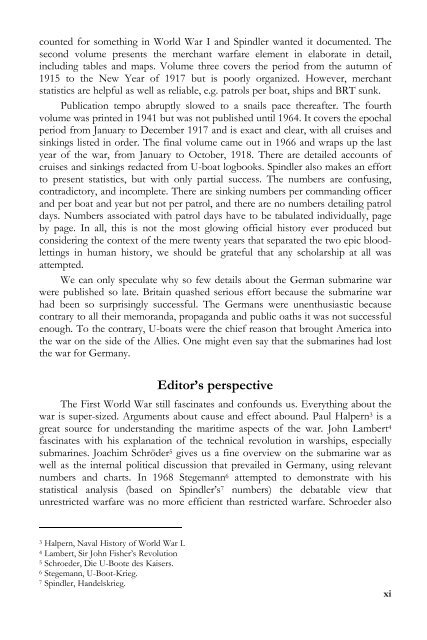German Submarine Warfare 1914-1918 in the Eyes - British Naval ...
German Submarine Warfare 1914-1918 in the Eyes - British Naval ...
German Submarine Warfare 1914-1918 in the Eyes - British Naval ...
Create successful ePaper yourself
Turn your PDF publications into a flip-book with our unique Google optimized e-Paper software.
counted for someth<strong>in</strong>g <strong>in</strong> World War I and Sp<strong>in</strong>dler wanted it documented. The<br />
second volume presents <strong>the</strong> merchant warfare element <strong>in</strong> elaborate <strong>in</strong> detail,<br />
<strong>in</strong>clud<strong>in</strong>g tables and maps. Volume three covers <strong>the</strong> period from <strong>the</strong> autumn of<br />
1915 to <strong>the</strong> New Year of 1917 but is poorly organized. However, merchant<br />
statistics are helpful as well as reliable, e.g. patrols per boat, ships and BRT sunk.<br />
Publication tempo abruptly slowed to a snails pace <strong>the</strong>reafter. The fourth<br />
volume was pr<strong>in</strong>ted <strong>in</strong> 1941 but was not published until 1964. It covers <strong>the</strong> epochal<br />
period from January to December 1917 and is exact and clear, with all cruises and<br />
s<strong>in</strong>k<strong>in</strong>gs listed <strong>in</strong> order. The f<strong>in</strong>al volume came out <strong>in</strong> 1966 and wraps up <strong>the</strong> last<br />
year of <strong>the</strong> war, from January to October, <strong>1918</strong>. There are detailed accounts of<br />
cruises and s<strong>in</strong>k<strong>in</strong>gs redacted from U-boat logbooks. Sp<strong>in</strong>dler also makes an effort<br />
to present statistics, but with only partial success. The numbers are confus<strong>in</strong>g,<br />
contradictory, and <strong>in</strong>complete. There are s<strong>in</strong>k<strong>in</strong>g numbers per command<strong>in</strong>g officer<br />
and per boat and year but not per patrol, and <strong>the</strong>re are no numbers detail<strong>in</strong>g patrol<br />
days. Numbers associated with patrol days have to be tabulated <strong>in</strong>dividually, page<br />
by page. In all, this is not <strong>the</strong> most glow<strong>in</strong>g official history ever produced but<br />
consider<strong>in</strong>g <strong>the</strong> context of <strong>the</strong> mere twenty years that separated <strong>the</strong> two epic bloodlett<strong>in</strong>gs<br />
<strong>in</strong> human history, we should be grateful that any scholarship at all was<br />
attempted.<br />
We can only speculate why so few details about <strong>the</strong> <strong>German</strong> submar<strong>in</strong>e war<br />
were published so late. Brita<strong>in</strong> quashed serious effort because <strong>the</strong> submar<strong>in</strong>e war<br />
had been so surpris<strong>in</strong>gly successful. The <strong>German</strong>s were unenthusiastic because<br />
contrary to all <strong>the</strong>ir memoranda, propaganda and public oaths it was not successful<br />
enough. To <strong>the</strong> contrary, U-boats were <strong>the</strong> chief reason that brought America <strong>in</strong>to<br />
<strong>the</strong> war on <strong>the</strong> side of <strong>the</strong> Allies. One might even say that <strong>the</strong> submar<strong>in</strong>es had lost<br />
<strong>the</strong> war for <strong>German</strong>y.<br />
Editor’s perspective<br />
The First World War still fasc<strong>in</strong>ates and confounds us. Everyth<strong>in</strong>g about <strong>the</strong><br />
war is super-sized. Arguments about cause and effect abound. Paul Halpern 3 is a<br />
great source for understand<strong>in</strong>g <strong>the</strong> maritime aspects of <strong>the</strong> war. John Lambert 4<br />
fasc<strong>in</strong>ates with his explanation of <strong>the</strong> technical revolution <strong>in</strong> warships, especially<br />
submar<strong>in</strong>es. Joachim Schröder 5 gives us a f<strong>in</strong>e overview on <strong>the</strong> submar<strong>in</strong>e war as<br />
well as <strong>the</strong> <strong>in</strong>ternal political discussion that prevailed <strong>in</strong> <strong>German</strong>y, us<strong>in</strong>g relevant<br />
numbers and charts. In 1968 Stegemann 6 attempted to demonstrate with his<br />
statistical analysis (based on Sp<strong>in</strong>dler’s 7 numbers) <strong>the</strong> debatable view that<br />
unrestricted warfare was no more efficient than restricted warfare. Schroeder also<br />
3 Halpern, <strong>Naval</strong> History of World War I.<br />
4 Lambert, Sir John Fisher’s Revolution<br />
5 Schroeder, Die U-Boote des Kaisers.<br />
6 Stegemann, U-Boot-Krieg.<br />
7 Sp<strong>in</strong>dler, Handelskrieg.<br />
xi




